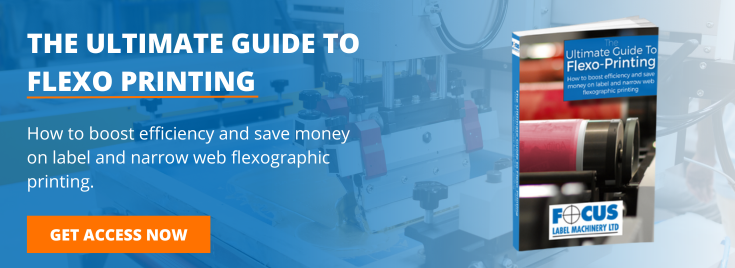
The flexographic printing process is a method of printing which has undergone many changes since the first presses were introduced in the late 19th century. Today, it represents a cost-effective and efficient means of printing many types of items, including packaging & labels. The latest machines have integrated advance technologies including Digital Drives and combining the latest Ink Jet systems. Modern Flexographic printing presses are able to print high definition images at high speeds, can print on numerous substrates, and they can be set up quickly with little down time between jobs. Flexo technology regarded as the most flexible method of commercially printing narrow web products used in packaging & the label industry suitable for low & high volume production.
In terms of cost savings, flexographic printing can help you ensure quality accuracy with each print, thereby reducing or eliminating added production time. Higher accuracy also results in fewer customer returns, which can also reduce costs and production time. Flexo offers repeatability and ability to print smaller volume orders more efficiently than other analogue systems. Flexographic printing also reduces waste.
The Printing Plate & Anilox Roller – Two Vital Components
The flexo print process cannot be accomplished without the anilox roller and printing plate.
The anilox roller is a cylinder containing thousands of small depressions. The roller obtains ink from the ink tank and deposits it evenly onto the printing plate. The printing plate is what transfers ink onto the substrate. Each colour in this process requires a separate plate, and each must be mounted correctly to ensure accuracy of image transfer.
Ink Control
Once the required amount of ink has been transferred from the anilox roller to the printing plate, its job is done. However, excess ink often remains on the anilox roller. If not removed, this ink will cause smudging, ghosting or a dirty image when the printing plate and substrate meet.
Scraping is required to remove this excess ink, and is done with a doctor blade. This blade passes over the anilox roller before its next turn, to ensure any excess ink is removed and returned to the ink tank. Using the correct quality Doctor blade is essential to maintain the correct volume of Ink and avoid damaging expensive anilox Rolls.
Regulating Print Quality
A flexographic printing press offers many different components which help facilities to increase efficiency and reduce their costs.
For instance, a tension controller regulates the tension of substrates as they enter the press and needs to remain constant to avoid register issues. Maintaining a clean web will avoid Ink/Printing plate contamination. The right impression pressure ensures that proper level of pressure is applied from the printing plate onto every label to avoid squashing the plate and printed image.
During the printing process, the stable drive ensures the flexo press prints all images cleanly and clearly. After printing, drying systems are in place to prevent smudging & contamination of inks. These systems can have a single drying method, or combine two or more methods. Common drying systems include UV and infra-red but need to be controlled accurately.
Continued Stability
The temperature of the press can compromise the integrity of some synthetics and unsupported films, resulting in costly reprinting and higher wastage. Chilling rollers are used in flexo presses to regulate substrate temperature as the substrate moves through the press. They’re also utilised for high temperature UV drying systems. Tension systems should be monitored and controlled to avoid affecting any sensitive webs.
After Printing
Flexo presses have several tension zones where substrate can be controlled, Unwind, Printing zone, Slitting & Converting zone & Rewind zones. These can be manually adjusted or have closed loop controlling sensors to ensure tension is maintained as substrate passes through each zone. Any waste product can be removed simultaneously. Printed products are wound onto rolls prior to being inspected for quality.
Despite the modernity and convenience of flexographic printers, costs can still rise. This can happen as the result of errors made prior to printing, for example:
Insufficient Instruction
Staff need to be trained properly in order to produce a high quality product. The right knowledge and sufficient training are required in order to understand the complexities of the machinery. Insufficient instruction and not ensuring familiarity with the machine before printing begins can lead to high amounts of wastage, damage to the machinery, and long delays for customers.
Not Choosing The Right Machine
A lower-priced flexo press may be easier on the company budget, but if it doesn’t have the features or speeds you’re looking for, costly delays or lower production output will most certainly be the result. Greater energy needs is also a common problem with low-quality machines, something that can quickly cancel out the money saved on machine purchase.
Not Considering The Desired Output
When considering the purchase of a new flexo printing press, you must first consider your own substrates and whether the machine can handle printing on them. It will take far more resources to try and adjust your existing processes to suit the machine’s requirements, than planning your print technology investments around the needs of your business. Wherever possible, a press should be tested before purchase to ensure it is suitable for your requirements.
Have a clear idea of your expectations & make a priority list to define actual needs against a ‘would be nice’ list. In understanding how flexo press components work together to reduce your costs, you can be in a better position to make an informed decision about the purchase of your next press.
For free, professional advice on how to get greater productivity and efficiency from your flexographic printers, please download our Ultimate Guide To Flexo-Printing. This new eBook explains the flexo-printing process and guides you through the latest technologies and print methodologies. Click here to download your copy.







